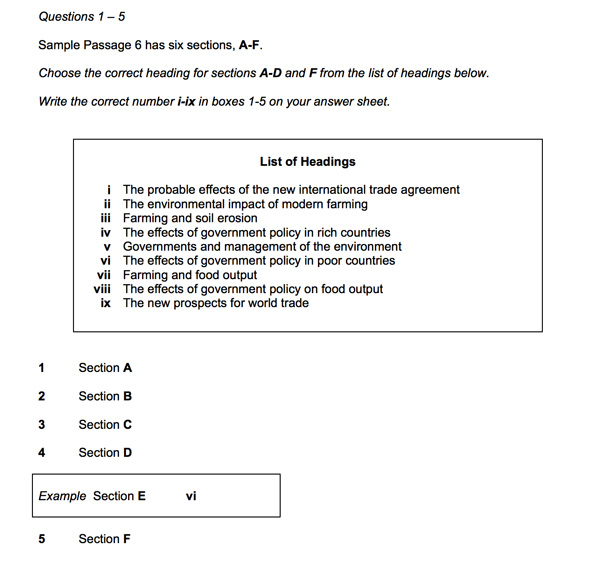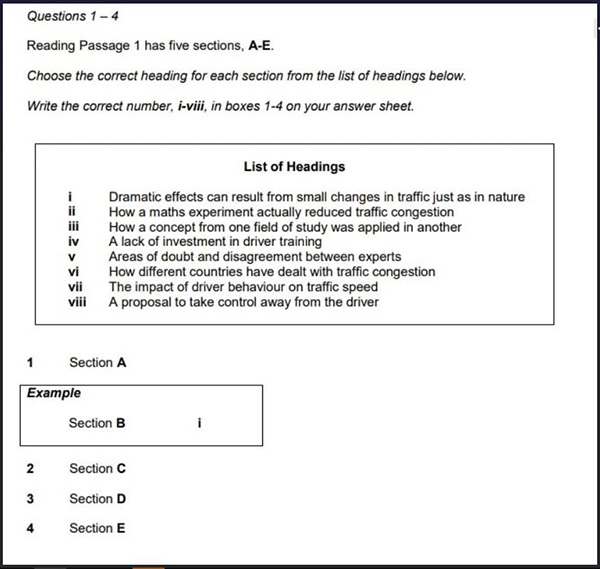IELTS Reading Matching Heading Questions
1. Introduction to matching heading questions in IELTS reading
Matching Heading Questions in IELTS Reading is presented in the form of a list of headings that summarise the general idea of paragraphs in the reading text.

There will be about 5 to 7 headings as represented by short sentences and you will be required to match each paragraph in the reading passage to one appropriate heading. Remember that there are always more given headings than the number of paragraphs and some paragraphs occasionally are not included in the answers.
Matching Heading Questions in IELTS Reading aims to test your:
- skimming technique to get the main idea of each paragraph
- ability to identify and understand keywords, synonyms and paraphrases
>> Read more: IELTS Reading Sentence Completion Questions
2. Matching heading strategies
Some candidates find reading the list of headings first more feasible to deal with Matching Heading Questions, while others prefer getting the main ideas of each paragraph before the headings. Therefore, in this part, two different strategies will be mentioned so that candidates can choose the more appropriate one fitting their learning style.

2.1. Strategy 1
a. Read the instructions
The first step to start Matching Heading Questions is to read the instruction carefully, except for the heading lists right below the requirement.
Here is the example of the instruction for Matching Heading Questions in IELTS Reading where you can find a given sample answer for Section B, which means heading “i” can be immediately eliminated for other sections.

b. Read the first paragraph
Now, take time to skim the first paragraph to get the main idea.
You should put more focus on the first one or two sentences and the last one of the paragraph which often contain the overall meaning. Also, don’t forget to skim the rest of the text quickly to make sure that you understand what the paragraph means.
For some sections consisting of more than one paragraph, it’s essential to get the main idea of each.
c. Summarise the main idea
Using your own words to briefly summarise the general meaning of the paragraph in short phrases only, and write it right beside each paragraph.
d. Read the headings
Turn to the list of headings, underline or highlight keywords in each so that you can discern those thoroughly and try to match your summary of the first paragraph to the suitable heading.
If there happen to be more than one headings that fit the first paragraph, note down all the possibilities since you may cross out one of those when doing the same process with other paragraphs.
e. Repeat for all sections
Repeat the first four steps for the other paragraphs to find out your answers.
You don’t have to find out the final answer for the paragraph that you are getting stuck on promptly, move on to the next one and mark for a later check. When you’ve reached out to the final question, your options will be limited for fewer headings to choose.
f. Eliminate used headings
Remember to cross out the headings that have been used in order not to get confused when dealing with other paragraphs.
>>> Practice now: IELTS Reading Practice Test
2.2. Strategy 2
a. Read the headings
Firstly, read the whole instruction including the headings and pay more attention to the list of headings.
While doing so, underline or highlight the keywords (especially names, numbers, dates or place names) for each heading and try to utterly understand it. Those keywords should not be the same as the topic or title of the reading passage. For instance, the topic is about “Tourism”, then keywords of the heading ‘The cost of tourism’ must be “cost” only.
| Questions 14-18
Reading Passage 136 has six sections A-F. Choose the most suitable headings for sections A-D and F from the list of headings below. Write the appropriate numbers i-ix in boxes 14-18 on your answer sheet.
List of Headings
i The probable effects of the new international trade agreement ii The environmental impact of modern farming iii Farming and soil erosion iv The effects of government policy in rich countries v Governments and management of the environment vi The effects of government policy in poor countries vii Farming and food output viii The effects of government policy on food output ix The new prospects for world trade 14 Section A 15 Section B 16 Section C 17 Section D |
b. Identify similar titles
The case of existing similar headings making it difficult for candidates in Matching Heading Questions is not infrequent. When spotting this problem, look at each option in detail and try to analyse the differences along with noting down those to distinguish.
c. Read the first paragraph
Now, it’s time to read the first paragraph to get the main idea. It’s suggested to pay more attention to the first one or two sentences and the final one & skim the other sentences.
Then, sum up the general meaning in a few words for later cross-checking with the headings.
d. Choose the matching heading
Let’s go back to the list of headings and opt for the best match.
If you make sure with any answer, cross out its heading immediately to eliminate it from further consideration. However, there are more than one alternatives, note them down and your options will be restricted at the end of the Matching Heading Questions.
e. Repeat for all sections
Repeat the process of cross-checking with the other paragraphs until finished.
3. Common problems mistakes & tips for matching heading questions in IELTS reading
| Common Problems & Mistakes | Tips |
| 1. Some headings appear to have the same meaning | Write down all the possible headings beside the paragraph and try to figure out the differences among them (based on keywords, meaning, context) |
| 2. Only read the first sentence of each paragraph and don’t understand deeply the main idea | It’s recommended to read not only the first one or two sentences but also the last one. And for more clarification, skim other sentences in that paragraph |
| 3. There sometimes exist matching words in the reading text with ones in the headings without the same meaning on the whole | Read carefully the headings to completely understand their meaning as well as differences with ones in the paragraph |
| 4. Leaving blank answers
The answer sheet should not be left with any blank |
Make sure your answer sheet will be fully filled even with uncertain answers |
| 5. Looking for the exact same words or phrases of the headings in the reading text
The examiners will surely use synonyms or paraphrases in the text to test your ability to identify those. (e.g. There could be many different synonyms of ‘beautiful’ like ‘attractive’, ‘pretty’, ‘lovely’ or ‘stunning’.) |
Think of synonyms and paraphrase when reading the headings |
|
6. Too much information to handle and not enough time Some may panic when facing Matching Heading Questions due to its large amount of information. Also, they are suggested to spend only 20 minutes for each passage, which may freak them out. |
Try to follow the suitable strategy and practice as much as possible so that you can get used to Matching Heading Questions in IELTS Reading |

Other tips for Matching Heading Questions in IELTS Reading:
- Do this question type first in order to both understand the passage as a whole that provides more information for other questions and save your time to some extent
- Don’t read the paragraph in a hurry as it leads to the misunderstanding of the paragraph and you will lose a chance to get a point
- Don’t spend too much time on one paragraph or heading. Move to the next one if you can’t find the answer and note your hesitant choice for later.
Matching Heading Questions may trouble and give you a hard time while doing an IELTS Reading test, but you can excel in this question type by applying the suitable strategy and tips along with practicing on a daily basis.
You can prepare for your IELTS test by using our free IELTS online tests on this website.

